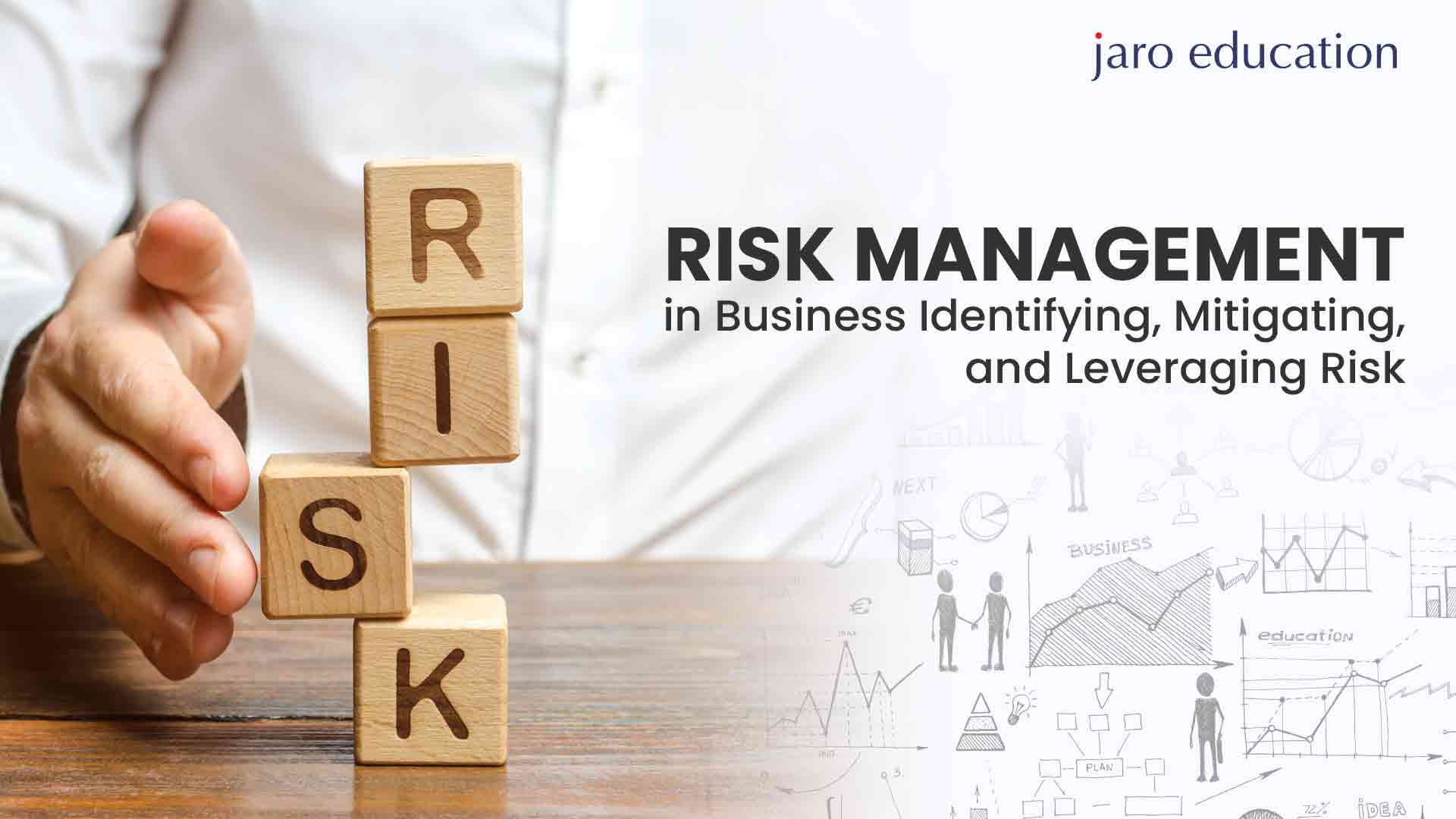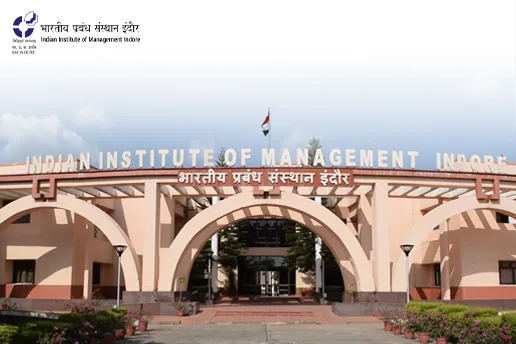
- jaro education
- 3, February 2024
- 11:00 am
Taking risks is normal in the business world, where factors like unpredictable financial markets, new technology, and ever-changing regulations contribute to a constant presence of risk. Globally successful companies recognise that effective risk management goes beyond merely preventing and minimising risks. It involves shaping these factors to their advantage and understanding that risk-taking is inherent in the corporate world due to factors like unpredictable financial markets, emerging technologies, and dynamic regulatory environments.
So, to understand the role of risk management in business, risk identification and mitigation techniques, and how multinational companies can leverage risk to spur innovation and growth, here is a comprehensive blog.
Recognising Risk in Business
In the business framework, risk is the possibility of suffering a loss or failing due to unforeseen circumstances or events. These risks can take many forms, including finances, operations, markets, strategy, and compliance. Competent business owners can reduce the adverse impacts of these potential hazards and exploit future opportunities by identifying and classifying them with precision.
Table of Contents
Risk Reciprocation
One of the following ways is typically used during risk reciprocation:
Avoidance
By accessing and eliminating the root of a risk, a company aims to settle for absolute safety.
Mitigation
Reducing the likelihood that a risk would materialise to decrease the estimated financial value associated with that risk.
Acceptance
A company might occasionally be compelled to take on a risk. This option is feasible if the business entity creates backup plans to lessen the risk’s consequences.
Essence of Risk Management Structures
Structures for risk management are sculpted to accomplish more than identifying potential hazards. A sound risk management framework should also estimate the uncertainties and project how they will affect a business establishment. It, therefore, calls for a decision-making ambience regarding accepting or rejecting risks. Structures for risk management are sculpted to accomplish more than identifying potential hazards. A sound risk management framework should also estimate the uncertainties and project how they will affect a business establishment. It, therefore, calls for a decision-making ambience regarding accepting or rejecting risks.
Strategies for Risk Identification
Realising and reckoning potential risks in a company setting is imperative before implementing risk management techniques. It necessitates an extensive review of legal requirements, external market variables, and internal business processes.
Here are the top eight risk identification checklists:
1. Productive Brainstorming
The process of assembling a team to brainstorm or come up with ideas and solutions to challenges that need to be addressed is known as brainstorming. This type of forum gives the concerned crew a chance to talk about real-time issues, make predictions, and consider the future of a project.
Brainstorming is helpful because it encourages communication and allows participants to hone their critical thinking abilities. To find out what your team believes to be the project’s pioneer risks, you can arrange a brainstorming session once a month, as it will fill the communication gap between employees and management.
2. Interviewing Stakeholders
Stakeholders are those people who have an interest in running the project. Their investment in a business is typically substantial, encompassing time, money, work, or all three combined. Interviewing stakeholders can thus help you understand what they perceive to be the significant risks associated with your project or organisation. They view risk as an investor, not an employee or a leader, and consider it from an external viewpoint. This perspective helps you understand your investors’ issues and how to resolve them.
3. NGT Concept
Another brainstorming technique that provides a deeper dive into the topic is the nominal group technique or NGT. In NGT attendees come up with their own ideas, instead of openly debating on the issue with other core members,. A high-ranking team member then invites each person for their ideas, which are recorded on a whiteboard or chart with any overlapping things crossed off.
After the team has discussed each item to make sure everyone is aware of it, you can begin working on ranking each one. The group can investigate the leading three items on the list in more detail, dissecting them and coming up with fixes. The NGT technique offers a more thorough resolution than brainstorming and relies on integrity and cohesive teamwork.
4. Affinity Chart
An affinity chart or diagram is a visual representation that classifies data according to commonalities between them. It suggests that each team member needs to write down the possible risks they perceive for the project or the organisation and then file every reaction under a few sections. In the process, risks can be categorised according to, for instance, financial, practical, or safety concerns. Affinity charts facilitate the assortment of the risks for each person. After obtaining the information, one can review and arrange the input. The group can then rank each risk and take appropriate action.
5. Requirements Analysis
A requirements analysis or review enables the core team to assess requirements frequently and promptly uncover potential risks. It examines the material, labour or financial needs of an upcoming project. To comprehend risks and conditions at every level of production, the relevant team of an organisation can finish a requirements review at any point within the project’s timeframe. Requirements are subject to alteration during manufacturing, which might affect the potential risk.
6. Project Planning
A project plan is a simple description of the requirements and the project. It covers the project’s duration, personnel and material requirements, and associated risks. A thorough project plan could aid the production team in comprehending the specifics of the work and what is required to accomplish the project’s objectives. It also gives stakeholders and investors insight into what they’re getting into, how the team is doing, and how to get a return on what they put into it.
7. Root Cause Analysis (RCA)
An examination of past project risks and their connections to the current project is termed root cause analysis. The underlying cause could be inadequate funding for antiquated machinery or subpar supplies. By identifying the inherent reasons, the core members may reduce recurring problems concerning the project or parent company and maximise project efficiency.
8. SWOT Analysis
Understanding a project’s or business’s risks, in addition to other crucial elements, is made possible with the help of a SWOT analysis. A rigorous SWOT analysis can assist the concerned team in better acknowledging how well they work in achieving targets and demonstrate to investors why a company or its relevant project is worthy of an investment. Four elements are examined in a SWOT analysis:

*wordstream.com
Strengths
Project-related abilities and areas where the team excels.
Weaknesses
Areas for improvement in output and effectiveness within the group.
Opportunities
Areas where the group or company can expand or develop.
Threats
Potential danger zones for the project or company and strategies the team might use to minimise them.
Entrepreneurs and their authorised representatives may pursue a recognised business management course where they will find a detailed interpretation of SWOT analysis.
Risk Mitigating Strategies
Global businesses must develop plans to mitigate risks after they have been discovered efficiently. Here are some tactics to consider:
1. Avoidance of Risk
Sometimes, the wisest course of action is to stay out of the risk. It might be accomplished by eliminating investments or operations that carry a lot of trouble or diversifying the company’s ethics to lessen exposure to certain risks.
2. Transfer of Risk
Transferring a risk entails giving control of managing specific hazards to an outside entity. It can often be achieved through contracts or insurance covering the company against threats.
3. Reduction of Risk
Risk reduction techniques aim to lower the possibility or effect of a risk gaining momentum. It can be performed by implementing robust internal controls, conducting frequent audits, enhancing security precautions, or putting cybersecurity procedures to good effect.
4. Being Ready for Emergencies
Business management staff can respond effectively to unforeseen events by implementing contingency plans and lessen the effect and recover more rapidly by outlining the precise actions to follow if a risk materializes.
5. Constant Observation and Assessment
Risk reduction is a continuous activity that calls for constant observation and assessment. Companies can pinpoint opportunities for enhancement and implement the required modifications by conducting routine evaluations of risk management tactics.
Taking Leverage to Increase Gains in the Marketplace
Businesses can identify, mitigate, and leverage risk to drive growth and innovation. Here are some methods for exact leverage:
1. A Mindset of Risk Acceptance
Encouraging a risk-taking culture could encourage staff members to take measured risks and spur creativity. Organisations can foster an environment that promotes innovation and entrepreneurship by establishing a culture in which failures are viewed as teaching opportunities.
2. Harmonious Methods
Multinational firms can take advantage of risk by forming strategic alliances with entities that match their abilities and risk appetite. By combining their resources and expertise, firms can take on more comprehensive, sophisticated tasks that would take more work alone.
3. Adopting New Technologies Right Away
Taking advantage of new technologies can be a calculated approach to reduce risk. International enterprises have the potential to acquire a competitive edge, disrupt established industries, and seize new economic possibilities by embracing revolutionary technologies early on.
4. Developing New Ideas via Trial and Error
Organisations can investigate novel concepts and initiatives by cultivating an innovative and experimental culture. They can explore potentially highly volatile, advantageous business ventures that could fundamentally alter their specific area by allocating cash for research and development.
5. Diversification and Expansion of the Trade Sector
Multinational companies can reduce risk by diversifying their offerings and extending their reach into new markets. Businesses that diversify their revenue streams and customer base might lower the danger of becoming overly reliant on a particular product or industry.
Conclusion
Sustaining a profitable business demands proficient risk management. Successful entrepreneurs can better negotiate uncertainty and take advantage of opportunities when they recognise the significance of risk assessment, mitigation, and leveraging. In line with this, prominent figures in the international sector understand that safeguarding their companies and opening up fresh opportunities for expansion and prosperity involves employing technology, fostering a culture of risk awareness, and consistently formulating risk mitigation strategies.
However, risk management in business has a lot more areas to comprehend than the ones discussed in this blog. If you want to hone your skills in managing risks in a business setup and learn more about the complex subject matter associated with the field, IIM Indore’s Executive Programme in Marktech and AI Driven Marketing can be your rightful resort as it is a course precisely designed by the highly experienced faculty of IIM Indore. Moreover, the faculty demonstrates each topic by using real business use cases and overall the course offers a holistic curriculum with 125 hours of immersive and interactive learning. If you are interested in joining this programme, contact Jaro Education.









